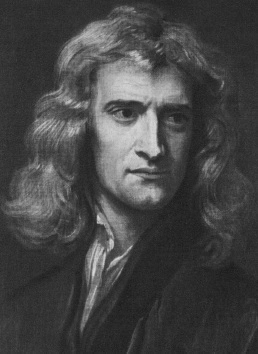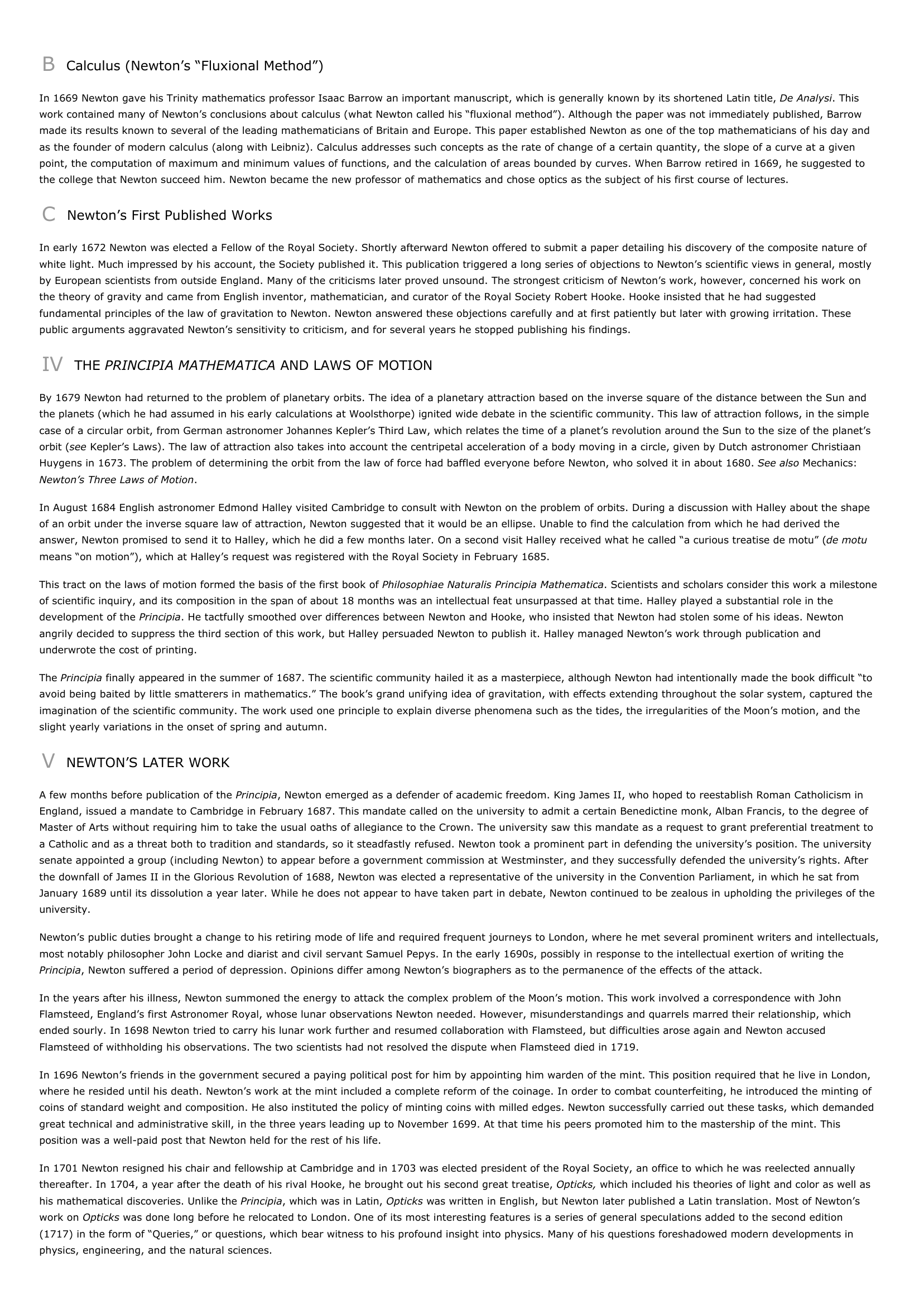Isaac NewtonIINTRODUCTIONIsaac Newton (1642-1727), English physicist, mathematician, and natural philosopher, considered one of the most important scientists of all time.
Publié le 10/05/2013

Extrait du document


«
B Calculus (Newton’s “Fluxional Method”)
In 1669 Newton gave his Trinity mathematics professor Isaac Barrow an important manuscript, which is generally known by its shortened Latin title, De Analysi .
This work contained many of Newton’s conclusions about calculus (what Newton called his “fluxional method”).
Although the paper was not immediately published, Barrowmade its results known to several of the leading mathematicians of Britain and Europe.
This paper established Newton as one of the top mathematicians of his day andas the founder of modern calculus (along with Leibniz).
Calculus addresses such concepts as the rate of change of a certain quantity, the slope of a curve at a givenpoint, the computation of maximum and minimum values of functions, and the calculation of areas bounded by curves.
When Barrow retired in 1669, he suggested tothe college that Newton succeed him.
Newton became the new professor of mathematics and chose optics as the subject of his first course of lectures.
C Newton’s First Published Works
In early 1672 Newton was elected a Fellow of the Royal Society.
Shortly afterward Newton offered to submit a paper detailing his discovery of the composite nature ofwhite light.
Much impressed by his account, the Society published it.
This publication triggered a long series of objections to Newton’s scientific views in general, mostlyby European scientists from outside England.
Many of the criticisms later proved unsound.
The strongest criticism of Newton’s work, however, concerned his work onthe theory of gravity and came from English inventor, mathematician, and curator of the Royal Society Robert Hooke.
Hooke insisted that he had suggestedfundamental principles of the law of gravitation to Newton.
Newton answered these objections carefully and at first patiently but later with growing irritation.
Thesepublic arguments aggravated Newton’s sensitivity to criticism, and for several years he stopped publishing his findings.
IV THE PRINCIPIA MATHEMATICA AND LAWS OF MOTION
By 1679 Newton had returned to the problem of planetary orbits.
The idea of a planetary attraction based on the inverse square of the distance between the Sun andthe planets (which he had assumed in his early calculations at Woolsthorpe) ignited wide debate in the scientific community.
This law of attraction follows, in the simplecase of a circular orbit, from German astronomer Johannes Kepler’s Third Law, which relates the time of a planet’s revolution around the Sun to the size of the planet’sorbit ( see Kepler’s Laws).
The law of attraction also takes into account the centripetal acceleration of a body moving in a circle, given by Dutch astronomer Christiaan Huygens in 1673.
The problem of determining the orbit from the law of force had baffled everyone before Newton, who solved it in about 1680.
See also Mechanics: Newton’s Three Laws of Motion .
In August 1684 English astronomer Edmond Halley visited Cambridge to consult with Newton on the problem of orbits.
During a discussion with Halley about the shapeof an orbit under the inverse square law of attraction, Newton suggested that it would be an ellipse.
Unable to find the calculation from which he had derived theanswer, Newton promised to send it to Halley, which he did a few months later.
On a second visit Halley received what he called “a curious treatise de motu” ( de motu means “on motion”), which at Halley’s request was registered with the Royal Society in February 1685.
This tract on the laws of motion formed the basis of the first book of Philosophiae Naturalis Principia Mathematica .
Scientists and scholars consider this work a milestone of scientific inquiry, and its composition in the span of about 18 months was an intellectual feat unsurpassed at that time.
Halley played a substantial role in thedevelopment of the Principia .
He tactfully smoothed over differences between Newton and Hooke, who insisted that Newton had stolen some of his ideas.
Newton angrily decided to suppress the third section of this work, but Halley persuaded Newton to publish it.
Halley managed Newton’s work through publication andunderwrote the cost of printing.
The Principia finally appeared in the summer of 1687.
The scientific community hailed it as a masterpiece, although Newton had intentionally made the book difficult “to avoid being baited by little smatterers in mathematics.” The book’s grand unifying idea of gravitation, with effects extending throughout the solar system, captured theimagination of the scientific community.
The work used one principle to explain diverse phenomena such as the tides, the irregularities of the Moon’s motion, and theslight yearly variations in the onset of spring and autumn.
V NEWTON’S LATER WORK
A few months before publication of the Principia , Newton emerged as a defender of academic freedom.
King James II, who hoped to reestablish Roman Catholicism in England, issued a mandate to Cambridge in February 1687.
This mandate called on the university to admit a certain Benedictine monk, Alban Francis, to the degree ofMaster of Arts without requiring him to take the usual oaths of allegiance to the Crown.
The university saw this mandate as a request to grant preferential treatment toa Catholic and as a threat both to tradition and standards, so it steadfastly refused.
Newton took a prominent part in defending the university’s position.
The universitysenate appointed a group (including Newton) to appear before a government commission at Westminster, and they successfully defended the university’s rights.
Afterthe downfall of James II in the Glorious Revolution of 1688, Newton was elected a representative of the university in the Convention Parliament, in which he sat fromJanuary 1689 until its dissolution a year later.
While he does not appear to have taken part in debate, Newton continued to be zealous in upholding the privileges of theuniversity.
Newton’s public duties brought a change to his retiring mode of life and required frequent journeys to London, where he met several prominent writers and intellectuals,most notably philosopher John Locke and diarist and civil servant Samuel Pepys.
In the early 1690s, possibly in response to the intellectual exertion of writing thePrincipia , Newton suffered a period of depression.
Opinions differ among Newton’s biographers as to the permanence of the effects of the attack.
In the years after his illness, Newton summoned the energy to attack the complex problem of the Moon’s motion.
This work involved a correspondence with JohnFlamsteed, England’s first Astronomer Royal, whose lunar observations Newton needed.
However, misunderstandings and quarrels marred their relationship, whichended sourly.
In 1698 Newton tried to carry his lunar work further and resumed collaboration with Flamsteed, but difficulties arose again and Newton accusedFlamsteed of withholding his observations.
The two scientists had not resolved the dispute when Flamsteed died in 1719.
In 1696 Newton’s friends in the government secured a paying political post for him by appointing him warden of the mint.
This position required that he live in London,where he resided until his death.
Newton’s work at the mint included a complete reform of the coinage.
In order to combat counterfeiting, he introduced the minting ofcoins of standard weight and composition.
He also instituted the policy of minting coins with milled edges.
Newton successfully carried out these tasks, which demandedgreat technical and administrative skill, in the three years leading up to November 1699.
At that time his peers promoted him to the mastership of the mint.
Thisposition was a well-paid post that Newton held for the rest of his life.
In 1701 Newton resigned his chair and fellowship at Cambridge and in 1703 was elected president of the Royal Society, an office to which he was reelected annuallythereafter.
In 1704, a year after the death of his rival Hooke, he brought out his second great treatise, Opticks, which included his theories of light and color as well as his mathematical discoveries.
Unlike the Principia , which was in Latin, Opticks was written in English, but Newton later published a Latin translation.
Most of Newton’s work on Opticks was done long before he relocated to London.
One of its most interesting features is a series of general speculations added to the second edition (1717) in the form of “Queries,” or questions, which bear witness to his profound insight into physics.
Many of his questions foreshadowed modern developments inphysics, engineering, and the natural sciences..
»
↓↓↓ APERÇU DU DOCUMENT ↓↓↓
Liens utiles
- Galileo I INTRODUCTION Galileo (1564-1642), Italian physicist and astronomer who, with German astronomer Johannes Kepler, initiated the scientific revolution that flowered in the work of English physicist Sir Isaac Newton.
- Wolfgang Amadeus Mozart I INTRODUCTION Wolfgang Amadeus Mozart Wolfgang Amadeus Mozart, an 18th-century Austrian classical composer and one of the most famous musicians of all time, came from a family of musicians that included his father and sister.
- Confucius I INTRODUCTION Confucius (551 or 552-479 BC), Chinese philosopher and educator, one of the most important individuals in Chinese history, and one of the most influential figures in world history.
- Karl Marx I INTRODUCTION Karl Marx (1818-1883), German political philosopher and revolutionary, the most important of all socialist thinkers and the creator of a system of thought called Marxism.
- Musical I INTRODUCTION George Gershwin American pianist, songwriter, and composer George Gershwin was one of the most important figures in popular song in the 1920s and 1930s.
















